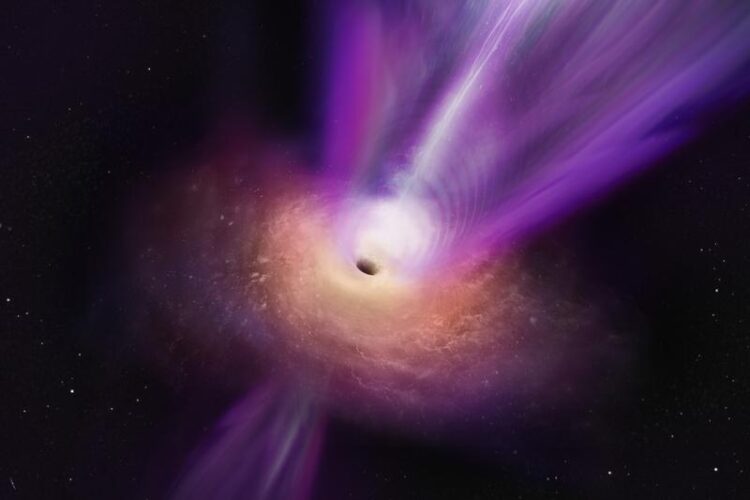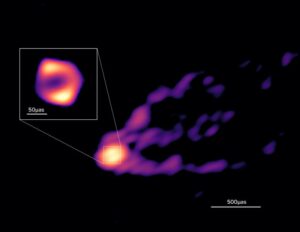How the black hole in M87 launches a jet

Artist’s conception showing a close-up view to the accretion flow and the jet emerging from black hole region in Messier 87.
(c) Sophia Dagnello, NRAO/AUI/NSF
An international team of scientists with participation of the MPIfR in Bonn has used new millimetre-wavelength observations to image for the first time the link between the ring-like structure that reveals the matter falling into the central black hole and the powerful relativistic jet in the prominent radio galaxy M87.
These images show the origin of the jet and the accretion flow near the central supermassive black hole. The new observations at 3.5 mm wavelength were obtained with the Global mm-VLBI Array, complemented by ALMA in Chile and the Greenland Telescope. The addition of these two observatories has greatly enhanced the imaging capabilities of the Global mm-VLBI Array.
Ru-Sen Lu, leader of a Max Planck Research Group at the Shanghai Astronomical Observatory of the Chinese Academy is thrilled and puzzled: “Previously, we had seen both the supermassive black hole and the jet far away from it in separate images, but now with the new image we have taken a panoramic view of the black hole together with its jet in a new observing band.” The matter surrounding the black hole is swallowed by a process called accretion. But no one has ever imaged this accretion flow directly. “The bigger and thicker ring we now see shows that the material falling into the black hole contributes significantly to the observed emission in the new image, which allows us to better understand the physical processes near the black hole”, adds Ru-Sen Lu.

(c) R. Lu et al, Nature 2023
“Participation of ALMA in GMVA observations has provided a substantial increase in sensitivity of detecting and imaging the radio emission from M87. This further increased the effective angular resolution and allowed us for the first time to image the ring-like structure at the very heart of M87 at the wavelength of 3.5 mm,” says Andrei Lobanov from the Max Planck Institute for Radio Astronomy (MPIfR), a member of the team of researchers. The diameter of the ring measured by the GMVA is 64 microarcseconds, which corresponds to the size of a small (5-inch/13.5-cm) selfie ring light as seen by an astronaut on the Moon looking back at Earth. As expected from the emission properties of the relativistic plasma in this region, the outer diameter of this ring-like structure is about 1.5 times larger than the one measured in previous observations by the Event Horizon Telescope at 1.3 mm.
“With the greatly improved imaging capabilities of the GMVA, we have gained a new perspective. We do indeed see the triple-ridged jet that we knew about from earlier VLBI observations,” says Thomas Krichbaum, leading author from the MPIfR team. “But now we can see how the jet emerges from the emission ring around the central black hole and we can measure the ring diameter also at another wavelength.”
“The spectacular image of the jet and ring in M87 is an important milestone, culminating in many years of collaborative efforts by our colleagues in Europe, including ESO, IRAM, Metsähovi, Yebes and Onsala, to align the GMVA array with phased ALMA for joint observations to reveal the finest details in the study of radio galaxies and quasars,” comments Eduardo Ros, scientist at MPIfR, European GMVA scheduler, and also a member of the research team.
Looking to next technological steps, Jae-Young Kim, from Kyungpook National University in Daegu, South Korea and MPIfR co-affiliated, says: “The next steps in the high-resolution studies of M87 address the study of the radio colour of the jet and black hole shadow, as well as polarisation measurements, which will reveal the magnetic field.” Planned steps for further improving the performance and sensitivity of the GMVA network invoke receiver upgrades that will allow multi-frequency phase referencing, as it is done already on shorter baselines with the Korean VLBI network.
J. Anton Zensus, director at the MPIfR and co-author of this publication, concludes: “These new results are so important because they give us for the first time a direct view on the region connecting the central accretion disc around the black hole and the jet in M87. Many years of developments of the VLBI technique have proved successful.”
Additional Information:
This research has made use of data obtained with the Global Millimeter VLBI Array (GMVA), which were correlated at the MPIfR. The GMVA consists of telescopes operated by the MPIfR, IRAM, Onsala, Metsähovi Radio Observatory, Yebes, the Korean VLBI Network, the Green Bank Observatory (GBT) and the Very Long Baseline Array (VLBA). The Effelsberg 100-m radio telescope participated in the 3.5 mm observations as part of the GMVA. The Greenland Telescope (GLT) joins GMVA observations on a best effort basis. The VLBA and the GBT are facilities of the National Science Foundation operated under cooperative agreement by Associated Universities, Inc. ALMA construction and operations are led by ESO on behalf of its Member States; by the National Radio Astronomy Observatory (NRAO), managed by Associated Universities, Inc. (AUI), on behalf of North America; and by the National Astronomical Observatory of Japan (NAOJ) on behalf of East Asia. The Joint ALMA Observatory (JAO) provides the unified leadership and management of the construction, commissioning and operation of ALMA.
The research team includes following researchers affiliated to the MPIfR: Ru-Sen Lu, Thomas Krichbaum, Andrei Lobanov, Jae-Young Kim, Eduardo Ros, Walter Alef, Silke Britzen, Jun Liu, Helge Rottmann, Tuomas Savolainen, J. Anton Zensus, Uwe Bach, Sven Dornbusch, Alexander Kraus, Nicholas MacDonald, Yurii Pidopryhora, Efthalia Traianou, and Jan Wagner.
Wissenschaftliche Ansprechpartner:
Dr. Thomas P. Krichbaum
Max-Planck-Institut für Radioastronomie
Bonn, Germany
Fon: +49 228 525-292
Mail: tkrichbaum@mpifr.de
Prof. Dr. Eduardo Ros
Max-Planck-Institut für Radioastronomie
Bonn, Germany
Fon: +49 228 525-125
Mail: ros@mpifr.de
Dr. Ru-Sen Lu
Shanghai Astronomical Observatory
Chinese Academy of Sciences, Shanghai
Fon: +86 21-34776078
Mail: rslu@shao.ac.cn
Originalpublikation:
R. Lu, K. Asada, T.P. Krichbaum, et al.: A ring-like accretion structure in M87 connecting its black hole and jet, Nature, April 27, 2023, doi:10.1038/s41586-023-05843-w
https://files.springernature.com/getResource/Full%20text%3A%20LU%2011434%2041586…
Weitere Informationen:
Media Contact
All latest news from the category: Physics and Astronomy
This area deals with the fundamental laws and building blocks of nature and how they interact, the properties and the behavior of matter, and research into space and time and their structures.
innovations-report provides in-depth reports and articles on subjects such as astrophysics, laser technologies, nuclear, quantum, particle and solid-state physics, nanotechnologies, planetary research and findings (Mars, Venus) and developments related to the Hubble Telescope.
Newest articles
Faster, more energy-efficient way to manufacture an industrially important chemical
Zirconium combined with silicon nitride enhances the conversion of propane — present in natural gas — needed to create in-demand plastic, polypropylene. Polypropylene is a common type of plastic found…

Energy planning in Ghana as a role model for the world
Improving the resilience of energy systems in the Global South. What criteria should we use to better plan for resilient energy systems? How do socio-economic, technical and climate change related…

Artificial blood vessels could improve heart bypass outcomes
Artificial blood vessels could improve heart bypass outcomes. 3D-printed blood vessels, which closely mimic the properties of human veins, could transform the treatment of cardiovascular diseases. Strong, flexible, gel-like tubes…





















